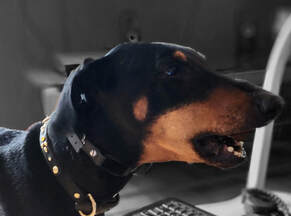
This blog post will go over the many strategies to begin to be able to communicate that barking should stop.
- Alert barking that does not stop.
- Demand barking for a toy, food, play, outside, and attention.
- Barking at every new noise.
- Barking at things on the television.
Here are some things to begin to bring nuisance barking under control:
- First and foremost, DO NOT reward or respond to actual nuisance barking by rewarding them with what they want.
- Be sure your dog does not need to always communicate their basic needs. They should have a reliable schedules for feeding, going out to potty, exercise, play, and comfortable shelter available to them. This will cut down on the barking in general. This is not necessarily nuisance barking, but it can lead to increased barking in general (or something worse).
- Be sure you have a training plan for your dog. "Quiet" is a command that can be trained just like "Sit" or "Down". You do need to be consistent however, and have good house rules about when barking should stop.
- Consider never training your dog to "speak". I do train my to speak, because I use it with dogs that need to get used to another dog barking, when I train client dogs. Another good reason to teach speak would be if you want people to be intimidated if they approach you or your car. Otherwise though, speak can really go sideways if you aren't a disciplined trainer. Some people use the "speak" command to train the quiet command. This can backfire on you, so I don't recommend it.
- Regarding item 3, while you don't want to teach "speak", you do need to know when your dog is likely to bark in order to train them the "quiet" command (in general). Think about all the triggers that make your dog bark. Many dogs will vocalize at traffic noises outside, dogs who walk by a window, dogs or people that they see out of a car window, another dog playing or running in a park or on the beach, wild life, and so on. If you are in a car, I do suggest training your dog while parked and never while driving. If you can identify those triggers, you can take time out of your day to expose your dog to them and reward them for ceasing to bark (or correct for not listening to the "quiet" command). This can be trickier than it seems. If your dog does not bark during a planned session though, you can reinforce the ability to be quiet with rewards (play, toy, food, affection, praise). Then just try another day or time.
- Redirect them to another activity. Many dogs who have been trained on toys will stop everything to play with that toy, and then forget what they were barking at.
- Calming behavioral exercises begin to accustom your dog to many different environments, if you practice in appropriate venues. This will also reduce occasions to bark annoyingly.
- Impulse control obedience exercises, such as stays and place, can help reduce your dog's need to bark as well. Not only does it teach them to manage their excitement or frustration (like calming behavioral exercises), but it also helps create confidence in your dog as well. This might seem to be at odds, but a confident dog is less likely to bark out of fear or agitation.
 RSS Feed
RSS Feed